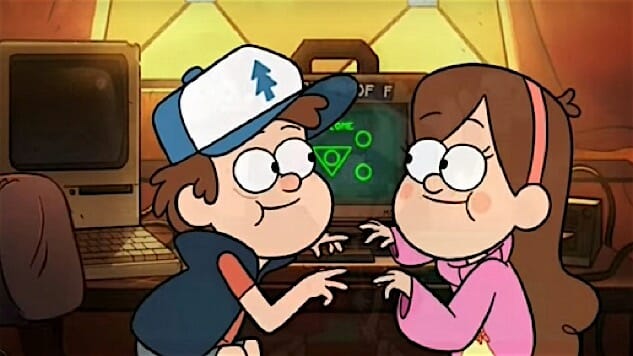A Eulogy For Gravity Falls

Valentine’s Day Weekend is supposed to be spent with your significant other,or alone on your couch with a pint of ice cream. I did neither of those things. Instead, I spent my weekend with Gravity Falls, the Disney XD cartoon to which I bade farewell with a marathon of binge-watching before tonight’s series finale at 7:00 p.m. Eastern. Maybe my live tweeting of the action brought you here, maybe not. Either way, I hope you’ll join me in paying my last respects to a television show that changed children’s cartoons forever.
I was lucky enough to have been introduced to Gravity Falls last summer, when I visited my cousin in Prague and she could not stop raving about it. After the first two episodes I was hooked, and then I was binge-watching the show in the span of a few days, and then I was getting a Dipper Pines hat for my birthday. Evidence that I’m not simply a manchild for behaving this way: even the great Louis C.K. liked the show enough to agree to voice a disembodied head with an arm sticking out of the top. And how about the extensive list of guest stars and presumed fans, which includes Jon Stewart, John Oliver, Nathan Fillion, and freaking Neil DeGrasse Tyson? Like so many others hip to this great show, I believe that the notion of a “kids’ cartoon” being exclusively for kids is bullshit, and Gravity Falls is absolutely worth your while, regardless of your tastes.
Gravity Falls’ strength, like that of any truly memorable show, has always been its characters —starting with Dipper and Mabel Pines, the 12-year-old co-protagonists. Their twin sibling relationship is, as far as I can tell, unique in animated protagonist history. On the surface, they seem a cut-and-dried case of the odd couple, with Dipper’s neuroticism, pubertal-onset insecurity, and analytical mind the foil to Mabel’s unfiltered joie de vivre and doe-eyed naïveté (portrayed magnificently by Kristen Schaal, whose performances highlight most of the episodes).
Plenty of fictional friends have showcased this dynamic, and they’ve all faced the archetypal challenge to such a relationship: overcoming the gap with love. But because Dipper and Mabel are twins, that love is closely intertwined with duty, which makes for a far more powerful bond. With duty come honesty, candor, and an intimate knowledge of each other’s deepest insecurities and flaws—all of which renders Dipper and Mabel totally vulnerable before each other. We get to see the inner psyches of the Pines twins in a way that no other show could ever reveal, because they’re each an X-ray into the other’s soul without any hint of romantic subtext (unless you’re a truly perverted DeviantArtist).
Mabel unlocks and elicits the pureness of Dipper’s heart, which often gets obscured by the ambitions and secret crushes that most guys deal with on a daily basis; in turn, Dipper unlocks and assuages Mabel’s deep-seated fear of change and the passage of time. Who else but Mabel could’ve convinced Dipper to declare his love for Wendy Corduroy, the coolest teenage girl who ever lived, knowing that it was futile and that he would have his heart ripped out in one of the show’s most visceral yet touching scenes? Who else but Dipper could’ve coaxed Mabel out of a fantasyland to rejoin a freak-show reality, rife with death, the ultimate human terror? These are heavy issues with which Hirsch and company have trusted their young audience—issues they can broach in an especially effective way because of Dipper and Mabel—and that trust 1.) has made Gravity Falls an amazing influence on children, and 2.) allowed it to resonate with an older audience.
Of course, Dipper and Mabel aren’t the only standout characters in Gravity Falls. There’s the well-intentioned, buffoonish handyman Soos, whose care for his Abuelita and non-relationship with his father humanize him in a way that stock clown characters have rarely been humanized in animated programs. There’s the über-cool Wendy Corduroy, the show’s superhero and Dipper’s crush, who showcases an incredible range of badassery while still acting like a real teenager (watching her break down at the end of “Boyz Crazy” is so brutal). And then there’s the kids’ Grunkle Stan, the most heartbreaking and dynamic character on the show. His transformation from narcissistic con man to outstanding father figure gains unfathomable depth when we find out that he’s been living with the guilt of having trapped his twin brother Ford on the other side of an interdimensional portal—and when Ford proves himself reckless, self-centered, and myopically focused on scientific inquiry, Stan doubles down on a devotion to Dipper and Mabel’s well-being.
“Everything I’ve worked for, everything I care about, it’s all for this family,” he proclaims in the seminal episode Not What He Seems. In hindsight, I’m eerily reminded of Walter White, and in a way, Stan’s arc reverses that of the meth kingpin; he must regain the trust of his kids, and he does so by becoming a better person and putting them ahead of his business. Many people are predicting that Stan will die in tonight’s series finale—someone will almost certainly die, because Hirsch has no reason to keep everyone alive—and if that turns out to be true, he will have completed his redemption story for the ages in the most tragic of fashions. I, for one, want to see a Disney story finally end in such an all-too-human Pyrrhic victory, and Gravity Falls has proven itself a brave enough kids’ program to make that a strong possibility.
-

-

-

-

-

-

-

-

-

-

-

-

-

-

-

-

-

-

-

-

-

-

-

-

-

-

-

-

-

-

-

-

-

-

-

-

-

-

-

-









































